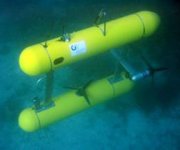
Mechatronics research covers the "application of field robotics" to many areas, including underwater vehicles |


Mechatronics research covers the "application of field robotics" to many areas, including underwater vehicles |
The School of Aerospace, Mechanical and Mechatronic Engineering offers four-year undergraduate programs leading to Bachelor of Engineering degrees in Aeronautical, Mechanical and Mechatronic Engineering as well as specialisations in Biomedical and Space engineering. There are also five-year combined degree programs with Science, Commerce, Arts, Medical Science and a six-year combined degree program with Law.
The School also offers 1 or 2 year full time coursework graduate programs leading to Master of Engineering degrees. This degree can also be done part-time by local students over a two or four year period. There are also 1 year minimum reseach Masters degrees and 3 year minimum Doctor of Philosophy degrees.
The coursework programs are designed to give specialist knowledge to those who have already completed a general Engineering undergraduate degree. This will result in enhanced career outcomes on graduation. All the degrees provide the fundamental mathematical, communications, critical thinking and problem solving skills that are required by any practicing Engineer.
The research degrees are designed to train those who plan on working in organisations such as universities or research establishments. On completion of our degree you are qualified to take up research or academic positions in Australia and all other major counties in the world based on qualification recognition agreements between countries.
All programs are designed to give flexibility in career outcomes on graduation. All the degrees provide the fundamental mathematical,communications,critical thinking and problem solving skills that are required by any practicing Engineer. The degrees are accredited by Engineers Australia the governing body of this profession in Australia. On completion of our degree you are qualified to take up Engineering positions in Australia and all other major counties in the world based based on qualification recognition agreements between the professional bodies internationally.
Aeronautical Engineering is the study of the mathematics, physics, computer science, material science and design philosophy underlying the analysis, design, manufacture and operation of aerospace vehicles. Aeronautical engineers find a use for their skills in research, airline maintenance and operations, aerospace design and manufacturing, in both civil and military environments. There is also good demand for graduates with aeronautical skills outside the aerospace sector.
Biomedical engineers apply engineering principles to understand, modify or control biological systems, and develop technology to monitor physiological functions and to assist in diagnosis and treatment of patients. Biomedical engineering is an interdisciplinary branch of engineering, encompassing areas of electrical, mechanical and chemical engineering. Subjects in biomedical and orthopaedic engineering as well as research opportunities in Electrical, Mechanical and Mechatronic Engineering are available. This degree meets the tertiary study entry requirements for the Graduate Medical Program.
Mechanical Engineering is a very broad branch of professional engineering. Mechanical engineers are found in almost every type of engineering activity. They are involved in power generation, transportation systems for land, sea and air, pollution control, environmental protection and, biomedical engineering. Mechanical Engineers are found in a wide range of industries which manufacture machinery and consumer goods and offer research and technical services. Mechanical engineers design machinery, engines, vehicles, agricultural and mining equipment, ships and household appliances. They are managers who run production lines, power stations and steel mills. They design and maintain coal conveyer systems, building services, oil and gas pipelines and port loading facilities. The great diversity of applications for mechanical engineers means they are much sought after in both commercial and industrial fields.
Mechatronic Engineering combines mechanical engineering, electronics and computing. It is the enabling technology of computer-automated manufacturing through the use of robots and automated machine tools. Mechatronics may be concerned with individual machines such as robots, or manufacturing systems automated in their entirety. Mechatronic engineers use computers and other digital systems to control industrial processes. They bring electronic, materials and mechanical sciences together to create a diverse range of products. These range from everyday products such as cameras, washing machines, photocopiers and anti-lock car brakes, to miniaturised substitutes for human organs and to powerful and precise computer-controlled machine tools used in manufacturing.
Space Engineering is the study of the design, testing and implementation of engineering components in one of the most demanding of environments - space. Students have the opportunity to complete the Space stream with the Aeronautical, Mechanical or Mechatronic engineering programs.
In all programs described above the first two years of undergraduate study provide students with an introduction to engineering science, design and manufacturing methods, management, computing, electronics and flight mechanics so that by the end of the second year, a broad field has been covered. In the third year, mechanical engineering students study in more depth the hardware, materials and manufacturing processes which are at the heart of mechanical engineering. In addition to this, mechatronics students study topics such as control, digital systems and computer technology, electronics and electrical machines. Three months' practical training in industry follows third year for all students. Aeronautical students will focus on the fundamentals of flight mechanics and dynamics, aircraft materials and structures, aerodynamics and aircraft design. In the fourth year, more advanced study is undertaken, which allows students to develop the professional skills that they will need after graduation. Emphasis is placed on using engineering science, up-to-date technologies and professional tools to solve practical problems. Specialisation in the final year is encouraged. Areas of specialisation include: management, thermofluids, environmental engineering, computational fluid dynamics, design, rheology, advanced materials, orthopaedic/biomedical engineering, mechatronics, aeronautical and space engineering. The relatively small class sizes in the final two years make for an informal and friendly atmosphere. A student branch of the American Institute of Aeronautics and Astronautics (AIAA) operates in the School which, together with the Royal Aeronautical Society, caters to the professional needs of the students.
© 2002-17 The University of Sydney. Last updated: 27 Jun 2017
ABN: 15 211 513 464. CRICOS number: 00026A. Phone: +61 2 9351 2341.
Authorised by: IT Director, AMME.